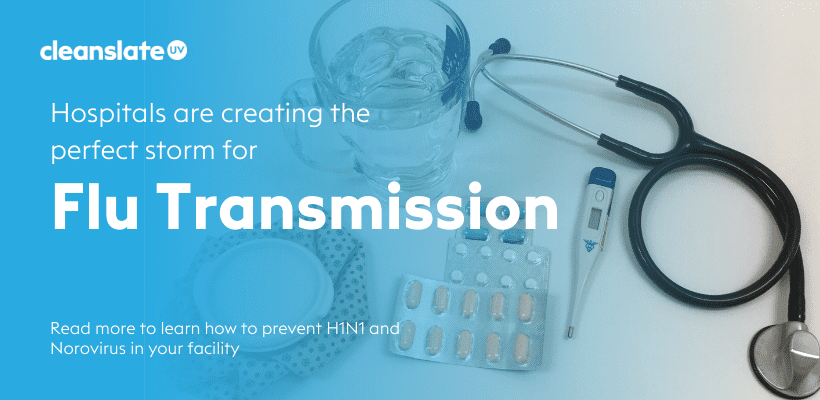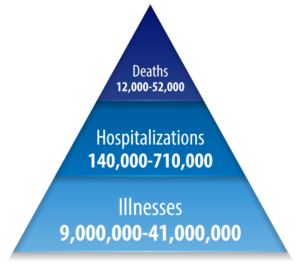The flu season is upon us and, year after year, it takes its toll on healthcare systems. The Centers of Disease and Control (CDC) estimates that between 2010 and 2020 the flu has resulted in between:
Image source: https://www.cdc.gov/flu/about/burden/index.html
What’s more of an issue is the rate at which the influenza-like viruses spread within hospitals.
These types of illnesses are usually different from the seasonal flu and are almost exclusively caught in healthcare settings, norovirus and H1N1.
Norovirus in Hospitals
While not technically an influenza, norovirus results in many of the same symptoms. This gastro illness is a serious threat to healthcare because hospitals are its prefered breeding ground. An average of 62.7% of norovirus outbreaks occur in hospitals!
There is not only an infection concern to the healthcare systems but the burden of treating these patients. In an average year in the USA, norovirus results in:
- 109,000 hospitalizations
- 465,000 ER visits
- 900 deaths
- over 2 million outpatient clinic visits
As you can tell from the stats above, norovirus is extremely contagious. You can contract this gastrointestinal virus from close contact with an infected person or by touching a contaminated surface.
H1N1 in Hospitals
H1N1 may sound like a pandemic of the past. Don’t let that fool you, H1N1 still has extreme relevance in healthcare settings.
H1N1 was declared a pandemic in 2009. Although no longer considered a global threat, community spread is still an ongoing concern and risk of transmission remains prevalent. This infectious flu is spread through droplets, either person to person or on surfaces.
Surface contamination is especially of concern because the virus can remain viable for up to 24 hours on non-porous surfaces, such as tables or cell phones.
Why Do These Illnesses Spread in Hospitals?
Hospitals create a perfect storm for flu-like infections.
The crowded nature of a hospital makes it easy for the virus to jump from one person to another, and many of these people have weakened immune systems or pre-existing conditions.
Staff will see many patients in a day and can unknowingly spread the virus between patients.
While technological strides have made for better patient care, often tablets and cellphones aren’t sanitized in-between patient use and can carry influenza droplets on the surface. These are shared between patients and staff members making for easy transmission.
Preventing Influenza-Like Illnesses in Hospitals
Various flu-like illnesses have been around for nearly 100 years and our healthcare systems have fine-tuned prevention.
First and foremost, there is a flu vaccine that, if taken annually, will not only help prevent infection but can reduce spread.
Avoiding close contact with those who are showing flu-like symptoms may sound obvious but it is often overlooked. While this is tricky if you are providing patient care, it is recommended to wear masks and keep distance when possible.
Finally, the CDC recommends proper hand hygiene. Good hand hygiene is effective in reducing the spread of the flu and many other illnesses. As a healthcare worker, it is crucial to build and maintain this habit.
An aspect of hand hygiene that need not be overlooked is our “third hand”, mobile devices. Every time we touch a contaminated surface, we recontaminate our hands. With tablets going between patient rooms it’s critical to sanitize between every touchpoint. The most common way of doing so is with chemical wipes. However, this can cause bottlenecks in staff workflows and leaves room for human error.
Over 300 hospitals worldwide have implemented CleanSlate UV to solve this issue. The 20 second cycle and touch-free device removal makes it the perfect solution for combating the flu this upcoming season.
CleanSlate UV has demonstrated an efficacy rate of 99.9791% and 99.99995% on norovirus and H1N1, respectively, both of which are common and highly contagious viruses.
To learn how CleanSlate UV can reduce viruses in your facility, you can read the following:
Go deeper into H1N1 and read a blog exclusively about this contagious influenza.
To see our full efficacy report and other helpful articles, check out our resources page.



